

Deforestation Facts for Kids - The World Counts. TheWorldCounts, 22 July, 2014 When you see paper and wood, what do you think of?
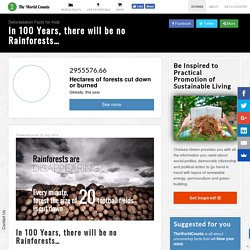
Do you think of the tree that was felled to make the product? Before we started to build cities many centuries ago, they say that 60% of the Earth was covered in Forests. Now, there is less than 10% left. Deforestation is when forests are converted for other purposes by cutting down the trees to clear the land for other use. What you need to know about Deforestation Can you imagine Earth without forests? 13 million hectares of forest have been cleared for other uses or by natural disaster. More facts: Rainforests cover only 6% of the world’s surface… yet they are home to more than 50% of the plant and animal species on Earth.A patch of rainforest measuring 4 square miles can contain as many as 1,500 flowering plants, 400 species of birds, 750 species of trees and 150 species of butterflies.
Why are Rainforests Important? Rainforests help regulate the Earth’s temperature and weather patterns. Reduce. References. CNN Explains: Deforestation. Deforestation Facts for Kids - The World Counts. Deforestation: Where is the world losing the most trees? Cheetos in crosshairs of deforestation controversy - Mar. 30, 2016. SumOfUs, an online consumer advocacy group, launched a campaign against Cheetos saying that its palm oil policy doesn't go far enough to ensure that it is deforestation-free.
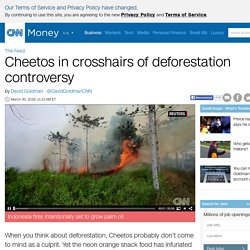
Palm oil has been a problematic ingredient, because it is often obtained by clearing rainforests, according to the World Wildlife Federation. That has threatened the habitats of many endangered species, including elephants, orangutans, rhinoceroses and tigers. Cheetos maker Frito-Lay, a subsidiary of PepsiCo (PEP), has committed to using sustainable palm oil that is grown on plantations -- not in rainforests. But that pledge doesn't take full effect until 2020. Yet SumOfUs has called PepsiCo's commitment "weak," criticizing Pepsi for its lack of enforcement.
"PepsiCo's palm oil policy is a step in the right direction, but it doesn't really do enough to prevent deforestation," said Katherine Tu, campaign leader at SumOfUS. A spokeswoman for Pepsi denied that IndoFood was excluded from its palm oil pledge. How to Fight Deforestation With Your Fork. Can going meatless once a week change the course of our rainforests?
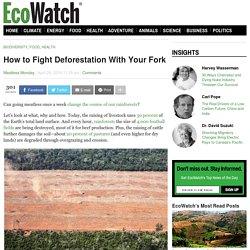
Let’s look at what, why and how. Today, the raising of livestock uses 30 percent of the Earth’s total land surface. And every hour, rainforests the size of 4,000 football fields are being destroyed, most of it for beef production. Plus, the raising of cattle further damages the soil—about 20 percent of pastures (and even higher for dry lands) are degraded through overgrazing and erosion. We simply can’t afford to lose our rainforests. Simple truth: As the world population explodes and the demand for meat grows, more and more rainforest will be destroyed. Deforestation Facts, Deforestation Information, Effects of Deforestation. Modern-Day Plague Deforestation is clearing Earth's forests on a massive scale, often resulting in damage to the quality of the land.

Forests still cover about 30 percent of the world’s land area, but swaths the size of Panama are lost each and every year. The world’s rain forests could completely vanish in a hundred years at the current rate of deforestation. Forests are cut down for many reasons, but most of them are related to money or to people’s need to provide for their families.The biggest driver of deforestation is agriculture. Farmers cut forests to provide more room for planting crops or grazing livestock. Logging operations, which provide the world’s wood and paper products, also cut countless trees each year. Not all deforestation is intentional. Deforestation has many negative effects on the environment. Deforestation also drives climate change. Trees also play a critical role in absorbing the greenhouse gases that fuel global warming. From Forest to Field: How Fire is Transforming the Amazon : Feature Articles. They pored over satellite images from the Landsat satellite captured between 1993 and 1995 to see what happened to all the area that was “deforested” in 1992.
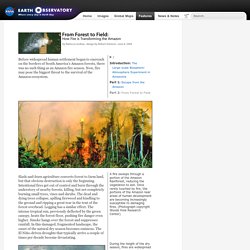
They decided that cleared areas with nice, straight lines that had sprung up next to pre-existing forest edges were probably intentional clearings for pasture or farmland. But Cochrane and his colleagues also discovered that much of the area labeled as deforested in 1992 was far from forest edges, was irregular in shape, and was already beginning to regrow. Amazon Destruction. Amazon Destruction Since 1978 over 750,000 square kilometers (289,000 square miles) of Amazon rainforest have been destroyed across Brazil, Peru, Colombia, Bolivia, Venezuela, Suriname, Guyana, and French Guiana.
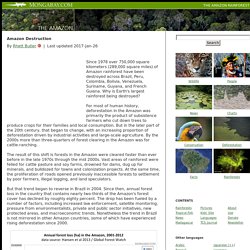
Why is Earth's largest rainforest being destroyed? For most of human history, deforestation in the Amazon was primarily the product of subsistence farmers who cut down trees to produce crops for their families and local consumption. But in the later part of the 20th century, that began to change, with an increasing proportion of deforestation driven by industrial activities and large-scale agriculture. By the 2000s more than three-quarters of forest clearing in the Amazon was for cattle-ranching. The result of this shift is forests in the Amazon were cleared faster than ever before in the late 1970s through the mid 2000s. But that trend began to reverse in Brazil in 2004.
Forest loss trends in the Amazon. CNN Explains: Deforestation.